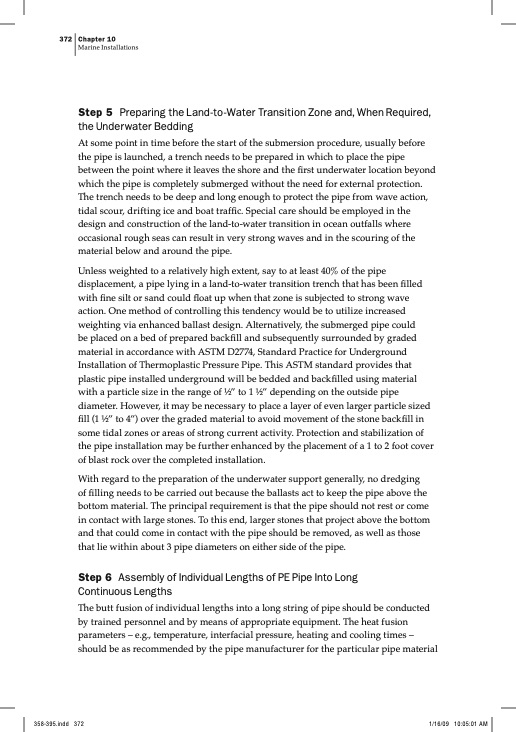
PDF Publication Title:
Text from PDF Page: 014
372 Chapter 10 Marine Installations Step 5 Preparing the Land-to-Water Transition Zone and, When Required, the Underwater Bedding At some point in time before the start of the submersion procedure, usually before the pipe is launched, a trench needs to be prepared in which to place the pipe between the point where it leaves the shore and the first underwater location beyond which the pipe is completely submerged without the need for external protection. The trench needs to be deep and long enough to protect the pipe from wave action, tidal scour, drifting ice and boat traffic. Special care should be employed in the design and construction of the land-to-water transition in ocean outfalls where occasional rough seas can result in very strong waves and in the scouring of the material below and around the pipe. Unless weighted to a relatively high extent, say to at least 40% of the pipe displacement, a pipe lying in a land-to-water transition trench that has been filled with fine silt or sand could float up when that zone is subjected to strong wave action. One method of controlling this tendency would be to utilize increased weighting via enhanced ballast design. Alternatively, the submerged pipe could be placed on a bed of prepared backfill and subsequently surrounded by graded material in accordance with ASTM D2774, Standard Practice for Underground Installation of Thermoplastic Pressure Pipe. This ASTM standard provides that plastic pipe installed underground will be bedded and backfilled using material with a particle size in the range of 1⁄2” to 1 1⁄2” depending on the outside pipe diameter. However, it may be necessary to place a layer of even larger particle sized fill (1 1⁄2” to 4”) over the graded material to avoid movement of the stone backfill in some tidal zones or areas of strong current activity. Protection and stabilization of the pipe installation may be further enhanced by the placement of a 1 to 2 foot cover of blast rock over the completed installation. With regard to the preparation of the underwater support generally, no dredging of filling needs to be carried out because the ballasts act to keep the pipe above the bottom material. The principal requirement is that the pipe should not rest or come in contact with large stones. To this end, larger stones that project above the bottom and that could come in contact with the pipe should be removed, as well as those that lie within about 3 pipe diameters on either side of the pipe. Step6 AssemblyofIndividualLengthsofPEPipeIntoLong Continuous Lengths The butt fusion of individual lengths into a long string of pipe should be conducted by trained personnel and by means of appropriate equipment. The heat fusion parameters – e.g., temperature, interfacial pressure, heating and cooling times – should be as recommended by the pipe manufacturer for the particular pipe materialPDF Image | Marine Installations PE

PDF Search Title:
Marine Installations PEOriginal File Name Searched:
PE-Marine-Installations.pdfDIY PDF Search: Google It | Yahoo | Bing
Development of a solar powered Electric Ship The Electricship website originally started off as a project to develop a comprehensive renewable, affordable, modular electric ship... More Info
Modular Boat Hull Composite The case for a unsinkable, modular composite hybrid boat hull... More Info
MS Burgenstock Hybrid Electric Catamaran Lake Lucerne Unique shuttle servicing Lucerne to the Burgenstock Resort... More Info
Ground Power Unit GPU Powered by Lithium Ion Batteries The goal of the Ground Power Unit is to provide a readily accessible, modular, ready-to-power solution for remote power... More Info
| CONTACT TEL: 608-238-6001 Email: greg@electricship.com | RSS | AMP |